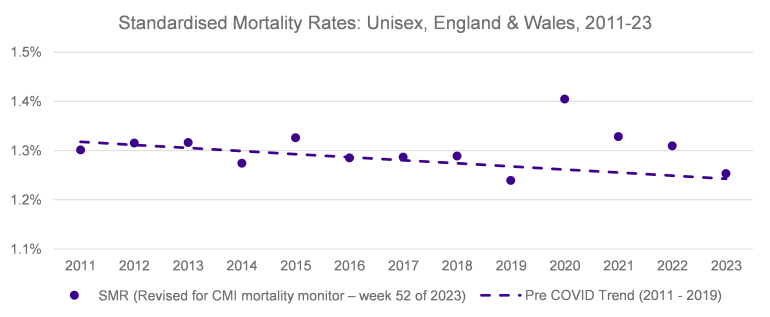Question:
Was there any excess mortality in the UK in 2023?
Answer:
It depends on how you define excess mortality and how you slice and dice the data… but there is an argument to say that 2023 mortality wasn’t far off pre-COVID trends.
The CMI's recent Mortality Monitor for week 52 of 2023 represented fascinating reading for those interested in UK population mortality trends. It contains two pieces of analysis which might indicate that 2023 was a lighter year for mortality rates than we’d previously estimated:
- Allowing for the ONS’s latest revised population estimates reduces the CMI’s estimate of 2023 mortality from 6.0% above 2019 levels1 down to 3.6% above 2019 levels.
- If we also allow for the period of unusually late reporting of deaths which occurred during December 2022, 2023 mortality could drop even further to just 1.2% above 2019 levels2
We should note that these figures continue to rely on estimates. However, it does seem a remarkable change, and one which might cause us to reconsider whether 2023 should be considered a year which contains “excess mortality" versus pre-COVID trends.
If we take the CMI’s latest estimates for mortality during 2023 (and for previous years), how does 2023 compare to the trend in mortality rates from 2011 to 2019? The chart below shows an estimate of Standardised Mortality Rates for England & Wales for the period 2011 through to 2023, with mortality rates adjusted based on the analysis presented in Appendices 1 and 2 of the CMI mortality monitor – week 52 of 2023. The dotted line shows the trend in Standardised Mortality Rates from 2011 to 2019.
We can see that the latest estimate for 2023 actually sits only very slightly above the 2011-19 trend line, indicating very little excess mortality relative to pre-COVID trends.

Key takeaways:
- There remains a fair bit of uncertainty as to precise mortality rates in 2023, and indeed in previous years.
- However, as the dust settles, 2023 is increasingly looking like a light year for mortality, quite possibly the second lightest year ever after 2019.
- If we make some optimistic assumptions (and noting that 2019 was a very light year), it is possible to conclude that there was actually little to no excess mortality in 2023 relative to pre-COVID trends.
Why does this matter?
When funding pension schemes, we need to make a prediction of future mortality rates. After several years of bad news on mortality improvements, this is perhaps the first positive sign that we might be able to get back on track of the trend of modest mortality improvements that were seen during the 2010s.
It might also indicate that we should place more weight on 2023 data in our projections than we previously thought (perhaps in combination with revisiting the decision to place any weight on 2022 data in the CMI model).
What do you think?
1 At end of week 51, 2023. See CMI mortality monitor – week 51 of 2023
2 For further details of this allowance see CMI mortality monitor Week 52 of 2023, Appendix 2




